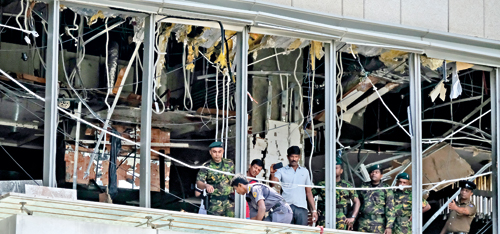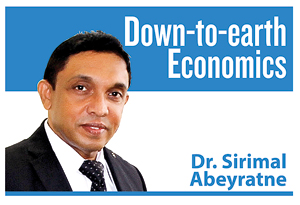Liberalisation and “security lapses”
View(s):
The devastated Shangri-La hotel. Pic by Amila Gamage.
I was hoping to bring about a different issue, but at the last moment I thought of changing the direction. Last Sunday, a wave of blasts shook the nation that had been enjoying 10 years of peace in the island. It was only after Sunday’s incidence that everyone realised what had been nurtured behind peace.
The incident led me to revisit some important links between economics and national security.
Sri Lanka had three decades of history dealing with economic policy-making and internal security problem, concurrently and constantly. And throughout this period of time, it was known to be an ‘open economy’.
We have more than enough lessons to learn from our own past for the present as well as for the future. In preparing the groundwork for the discussion today, let me elaborate some of the issues from the past.
Economy in the midst of civil wars
Since the early 1980s Sri Lanka had to deal with two facets of civil war: One was the Tamil separatist movement in the North and finally led by the LTTE. The other was the Sinhala militant movement in the South, which was erupted twice and led by the JVP.
There is a remarkable observation made by many analysts from around the world who have written about Sri Lanka’s economic development or civil war or both: Unlike most of the other war-stricken countries, Sri Lanka has been able to sustain its economic growth and human development standards even in the midst of civil wars.
For instance, Frances Stewart and Meghan O’Sullivan from the Oxford University in one of their joint publications in 1999 wrote: “…unlike most conflict-ridden countries, Sri Lanka has enjoyed sustained economic growth and continued overall improvement in human indicators even while suffering violent conflict on a large scale”.
Outbreak of civil wars
Although there might be some other reasons too, but the most crucial factor underlying Sri Lanka’s outstanding performance is trade liberalisation prior to the outbreak of civil wars.
Imagine that the “twin civil wars” had erupted before trade liberalization in 1977: There was a shortage of food, clothing, medicine and all basic needs. There was neither production to meet the domestic demand nor foreign exchange even to import. Economy was growing merely at 2 per cent on average. Unemployment was rampant and, over 20 per cent of people had no jobs. The poverty-stricken majority of the people were barely surviving.
If the two civil wars erupted in the middle of such an agony, Sri Lanka’s economic development would have been an entirely a different story today. There is no doubt that the civil wars have been breed and nurtured within that economic setup, but they erupted into a violent stage after trade liberalisation reforms in 1977.
When the wars erupted, the seeds of economic growth and export expansion had already been planted. Both public and private investment was growing and, unemployment was falling. The country had already acquired economic strength to cope with negative repercussions of civil wars.
Miscalculations
Some analysts, however, calculated the sequence of events to infer that it was trade liberalisation in 1977 that led to youth unrests and, finally the civil wars in the 1980s!
Surprisingly, they have argued that dismantling of social welfare, negligence of rural sector and the widening inequality in the liberalised trade regime moved the country away from social peace and dragged it into insurrections. Along the similar lines, some others have argued that the vulnerability of the rural socioeconomic setting to open economy has been in the heart of youth uprisings.
They all forget one simple thing: It was long before trade liberalisation when the civil wars commenced breeding in the North as well as in the South.
Impediments to liberalisation
Although Sri Lanka was an early-mover to open its economy with the introduction of liberalisation policies well before many other countries in Asia, it is a fact that the country did not turn out to be a ‘high-performing’ economy. Growth rate was never sustained at higher rates; export expansion was much slower and foreign investment was much smaller than those of many other countries which started liberalisation much later than Sri Lanka.
What was the reason? The deterioration of the security condition of the country thwarted investment promotion and export expansion on the one hand. The same issue impeded and, in fact, reversed the liberalisation process on other hand.
The government had a policy dilemma to face: It is understandable that as part of the adjustment costs, trade liberalisation wields pressure on the government budget as well as the trade deficit – the country never recovered from both issues. At the same time, military expenditure was soaring against the ‘twin wars’ amplifying the pressure on both government expenditure and import expenditure.
As a result, Sri Lanka messed up the liberalisation process and brought about para-tariff measures to compensate for the revenue losses due to liberalisation.
The ‘open economy’ did not perform as expected. Above all, it provided enough ammunition to the ‘opponents of liberalisation’ to weaken the liberalisation policy thrust!
Falling tax revenue
Even with the imposition of multiple taxes including para-tariffs on trade and economic activities, Sri Lanka experienced a steady fall in government’s tax revenue as a share of GDP. Tax revenue which was over 20 per cent of GDP 20 years ago has declined to 10 per cent of GDP by 2014. This has now increased to 12 per cent of GDP because of the expansion of the tax base rather than the improvement in taxable income growth.
Falling tax revenue has imposed an additional obstacle to liberalisation. Tax revenue should rise with better economic performance – higher growth originating from the expansion of taxable economic activities.
Until and unless we ensure that the groundwork has been prepared for the take-off, liberalisation efforts might have a painful path to go through. And political impediments to liberalisation might get stronger too weakening even the future possibilities for liberalisation.
As long as the economy cannot stand on its own strength, it has to survive on government assistance, foreign trade concessions and bilateral trading arrangements; we continued with all that.
Liberalisation, revisited
The liberalisation programme that was kept aside for the past 10-years is now beginning to receive attention, though at a slower pace. There is no question about its ‘necessity’ because Sri Lanka has deviated from its initial open economy model.
 Liberalisation should come as an integral part of an overall reform agenda in order to establish a competitive business environment. The point is that, now there is another important factor that we cannot ignore at all – the security aspect.
Liberalisation should come as an integral part of an overall reform agenda in order to establish a competitive business environment. The point is that, now there is another important factor that we cannot ignore at all – the security aspect.
As security issues overwhelm the effects of policy reforms, investors are unlikely to turn up and investment is unlikely to pick up. Then what would be the impact of liberalisation? It is more damaging than repairing!
Open economy means that there should be minimal taxes and regulatory restrictions on economic activity. The government revenue should rise not from multiple taxes and higher tax rates, but from greater volumes of economic activity, which depend on increased investment. Trade deficit should fall, not from lower imports but higher exports, which depend on increased investment.
Wrong time for right step
This is the wrong timing for a right step. We have already missed the bus and, need to wait for the next. Once the ‘security lapses’ are resolved and investor confidence is restored, then there will be time again to undertake policy reforms.
The economy has always been resilient in the past overcoming the challenges. In the same way, we will be able to restore normalcy and start building the economy again. (The writer is a Professor of Economics at the University of Colombo and can be reached at sirimal@econ.cmb.ac.lk).


